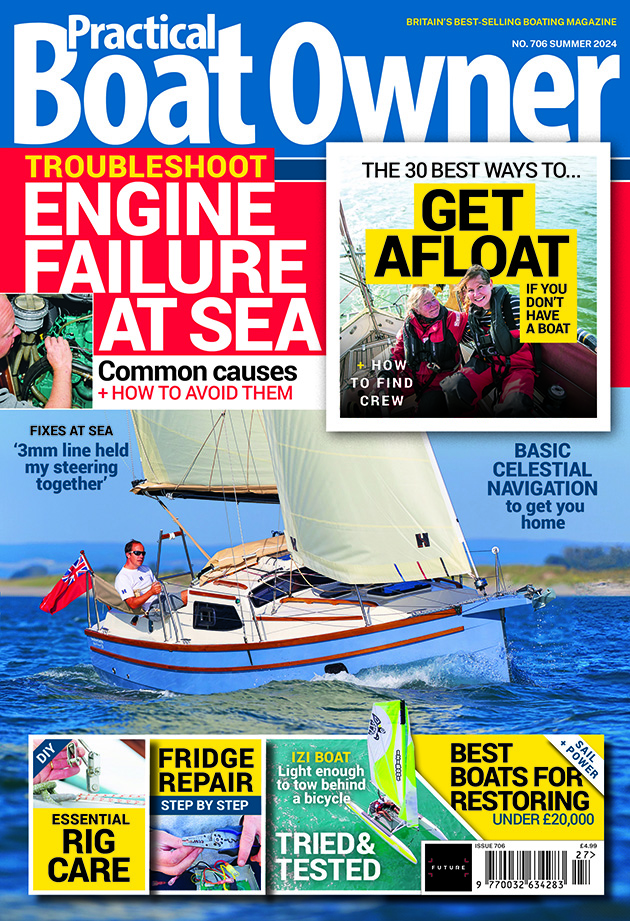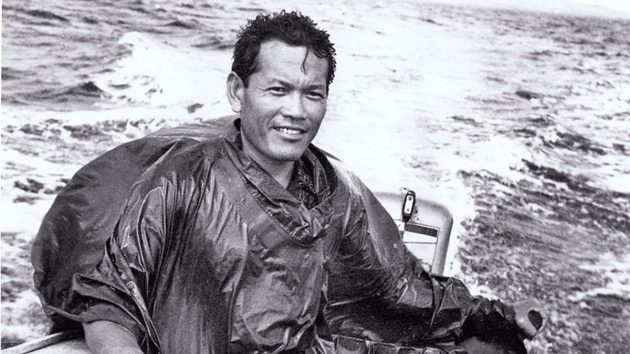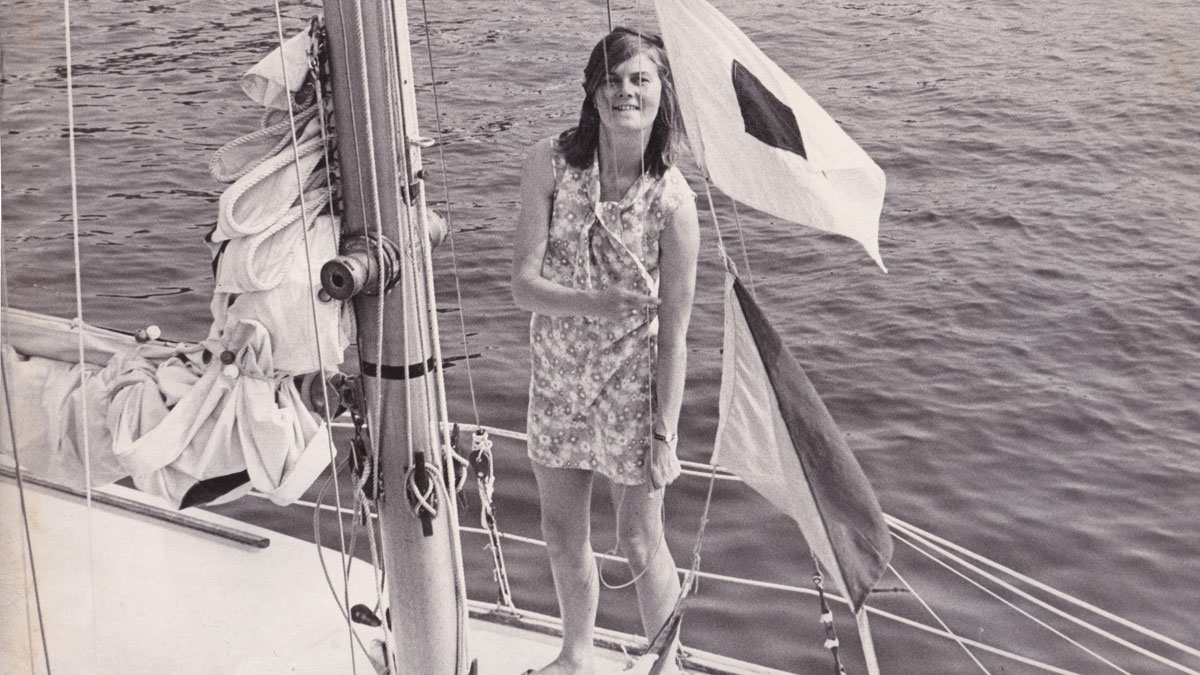Richard King and Serafin Colmenares Jr. look back at the remarkable Pacific voyage of Florentino Das in his 24ft home-built boat
Florentino Das: a shoestring voyage of adventure across the Pacific
Escaping the recent horrors of World War II, thousands of veterans and civilians in the 1950s sought respite and freedom out at sea in small boats, write Richard King and Serafin Colmenares Jr.
They include a stream of now famous single-handers such as Edward Allcard, Ann Davison, and Sir Francis Chichester.
Over in the Pacific Ocean, a solo voyage by a DIY fisherman-carpenter-mechanic was no less extraordinary, yet it is now barely remembered in sailing histories.
This man’s reasons were less about post-war escape and more about returning home and earning pride for his family and community.
Born in 1918, Florentino Resulta Das grew up on the island of Samar in the Philippines, the son of a man who ran a 60ft ferry.

Model of Florentino Das’s Lady Timarau at the Filipino Community Center, Honolulu, Hawaiʻi. Credit: Serafin P. Colmenares, Jr
Florentino Das grew up learning from his father, helping him build boats, and marvelling at his ability to predict landfalls based on the wind and stars.
At 16, Das stowed away on an English freighter to Hawaiʻi. In the middle of the Great Depression, he found work where he could, including as a boxer.
He married Gloria Lorita Espartino; together they raised eight children.
Florentino Das worked as a fishing boat captain, carpenter, ceramicist, and at the Pearl Harbour shipyard. He repaired boats and cars.
After some 20 years in Hawaiʻi, Das decided to return home.
He couldn’t afford a passage by ship or plane, so resolved to take a small boat with the hopes of, once home, establishing a fishing or ferry business to fund plane tickets for his family.

Florentino Das on departure day. Crowds saw him off and priests blessed his voyage. Credit: Collection of Pio Arce
With the help of his children over three years in his backyard, Florentino Das built Lady Timarau using a Navy surplus hull.
He replaced structural parts with spare timbers, added a mast and a centreboard, and scavenged parts of other vessels to construct a 24ft wooden boat with four watertight compartments.
It had a self-draining cockpit and was built so he could dog himself into the cabin in any weather. Das set up the sloop with two 25hp outboard engines.
His project generated some sponsorship from the Timarau Club of Honolulu.
Florentino Das departed from Kewalo Basin in Honolulu on 14 May, 1955.
Only a couple of hours out of the harbour, his main boom broke. He replaced this with an oar.

Das’s voyage made headlines in Hawaiʻi and his voyage was followed by the press. Credit: The Honolulu Advertiser, April 26, 1956
As Das caught up on sleep, he realised he’d forgotten some key parts for his outboards, a mirror, ‘sunburn oil’, a sea anchor, a regular anchor, nets for fishing, and spare batteries for his radio.
Then in early rough weather, he was, as he wrote, “shaken like a dice in a cup.”
Yet soon Das began to settle in. He had a sextant, a compass, two wrist watches, and he knew the stars well.
He had a mainsail with a short gaff, a staysail, and a spinnaker of parachute material.
He used a small stove to make coffee and to warm food, and he’d loaded 35gal of water, four gallons of wine, four quarts of whisky, and 150gal of gasoline, stowing this intentionally for stability and ballast.

The Florentino Das commemorative marker at Kewalo Basin in Honolulu, Hawai’i, dedicated 2006. Credit: Serafin P. Colmenares, Jr
He also had a small motorcycle wedged in one compartment for when he reached the Philippines.
To begin with, he couldn’t get his boat to steer itself, so Das became terribly sleep-deprived.
Continuing west, the winds mostly favourable, he watched the sky for Hawaiʻi-bound aircraft to confirm his bearings. There was little rain, so he worried about his supply of drinking water.
In calms, Das constructed a higher bracket for the motors, because they were getting too wet when not in use and needed constant attention.
He rebuilt one of the ignitions.
His watch set to GMT stopped, but he still felt he had a reasonable sense of where he was, so he steered north of west, to stay above the Marshall Islands to avoid the reefs.
Soon Florentino Das got the idea to rig up to his battery an old car radio that he had aboard.

Relatives and friends of Florentino Das pose beside his statue in his hometown of Allen, Northern Samar, at its dedication in 2018. Credit: Courtesy of Pio Arce
He managed to make this work, using the mast stays as an antenna. Sixteen days out from Oahu he tuned in to a radio station from Japan, then one from Hawaiʻi, from which he was able to reset his GMT watch on their time signal and calculate his longitude.
Meanwhile, Lady Timarau was leaking around the centreboard trunk, requiring regular repairs to the bilge pump to keep ahead of it.
But once Das figured out a system of how to get the boat to steer itself, all was going pretty well.
He wrote on 3 June 1955: “I have been a good boy all my life, so I guess the good Lord will not leave me in the lurch. I am not a bit worried.”
But conditions worsened in the weeks that followed. The engines sputtered out of commission and the hull leaked so badly that he had to pump almost continuously.
On 19 June, Florentino Das signalled a Japanese fishing boat that towed him for about 500 miles to a harbour on the island of Pohnpei.
When he requested money for repairs from his sponsors in Hawaiʻi, some tried to raise funds, while others asked him to abandon the voyage.
Das felt obligated to continue, saying in a radio interview that he “wanted to prove that Filipinos are not only good boxers but also good boatbuilders and sailors.”
Das spent eight months in Pohnpei, repairing his boat and waiting out the typhoon season, until he continued for the second half of his voyage, stopping in the Chuuk Islands.
He made landfall in Yap, where he stayed for a few weeks before his final approach to the Philippines.

Richard J King’s book features a chapter on Florentino Das
He managed to scoot south of the path of Typhoon Thelma, but still, he and Lady Timarau were battered by winds and seas until he anchored off a beach at Siargao Island on 25 April 1956, completing a 346-day, 4,700-mile odyssey.
Florentino Das continued to his home in Samar. From here he was escorted by the Philippine Navy and Coast Guard to Manila, where the new hero was paraded through the streets.
Das was awarded the Legion of Honour, named an honorary Commodore of the Philippine Navy, and was given the keys to Manila.
Back in Hawaiʻi there was a large banquet for his wife, who was named ‘Mother of the Year’.
A fund was set up in Honolulu to raise money to send the whole family to Manila. Yet the celebrations flared out too quickly.
Florentino Das was never able to gain any financial footing. The fund in Hawaiʻi couldn’t raise enough money.
As the years went on, he and his wife agreed to divorce so she could remarry someone in Hawaiʻi with an income.
Das remarried, too, but he remained poor, and he began to lose his eyesight from complications of diabetes and high blood pressure.
In 1962 Lady Timarau sank at the dock in a hurricane. In 1964, at only 46 years old, the adventurer died of organ failure.
Though the name of Florentino Das is rarely mentioned in yachting books, there are two humble monuments to his voyage in the Philippines, a plaque in Honolulu and Hawaiʻi’s Filipino Community Center keeps a scale model of Lady Timarau.
On Siargao Island, Das’s arrival is celebrated annually as ‘Lone Voyagers Day’.
Most importantly, for his descendants in Hawaiʻi and the Philippines, the heroism of his solo voyage remains an inspiring example of one individual’s success, a fulfilment of a personal dream and a true shoestring voyage, while it is valued still more as an achievement for the Filipino people and a triumph of faith.
Read more about Florentino Das
Bold Dream: Uncommon Valor, The Florentino Das Story by Serafin P Colmenares Jr, Cecilia D Noble, and Patricia E Halagao
To learn more about this in the context of other solo sailors see Sailing Alone: A History by Richard J King
Continues below…
Ann Davison: transatlantic first
Ann Davison became the first woman to sail across the Atlantic solo when she arrived in Dominica in January 1953.…
The pioneering sailor you’ve probably never heard of: Nicolette Milnes Walker
Nicolette Milnes Walker was the first woman to sail solo and non-stop from the UK to the USA. Julia Jones…
Frank Cowper – Sailing Tours the forefather of modern cruising
Frank Cowper published the first amateur cruising guides 120 years ago. Ben Meakins reads Cowper’s Sailing Tours and plans his…
Margaret and Frank Dye: open boat pioneers
Roger Barnes reflects on the legacy of small-boat sailors Margaret and Frank Dye
Enjoy reading Florentino Das: a shoestring voyage of adventure across the Pacific in a 24ft boat?

A subscription to Practical Boat Owner magazine costs around 40% less than the cover price.
Print and digital editions are available through Magazines Direct – where you can also find the latest deals.
PBO is packed with information to help you get the most from boat ownership – whether sail or power.
-
-
-
- Take your DIY skills to the next level with trusted advice on boat maintenance and repairs
- Impartial in-depth gear reviews
- Practical cruising tips for making the most of your time afloat
-
-
Follow us on Facebook, Instagram, TikTok and Twitter








